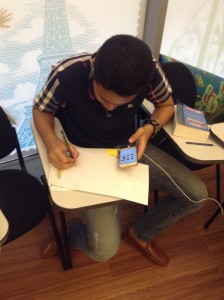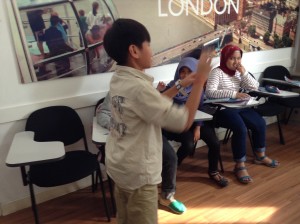The lockdown won’t get us down

Pravita Indriati (Indonesia) shares a lesson idea (for a pre-teen class ages 10-11) to help students share their feelings about the pandemic lockdown
It has been more than a year since the beginning of the COVID-19 outbreak that has impacted our lives, the business sectors, and education. Schools have been closed and have switched to online learning. Students have to attend school through online platforms, such as Zoom, GoogleMeet, Teams and more. They are unable to meet their friends, family and relatives. This has had a tremendous impact on our lives, not only on adults but also on children.
In the first wave of the outbreak, Indonesia experienced a total lockdown when we were unable to go places and meet people. It was quite a shock to us as adults and children. Weeks and months have passed, students’ interest in learning has decreased due to a number of reasons: zoom-fatigue, inability to travel and be social, internet connection issues and more. As a result, students skipped classes, were demotivated to participate in activities; and I saw frowning faces everywhere.
I work in an English language course in Indonesia, teaching different classes and levels for 1-1.5 hours each day for six days. In one of my classes, which had gotten worse, I quickly took the initiative to “get out” of the curriculum and give students an activity that allowed them to share their feelings about the current situation and learn from each other.
The lesson (for a pre-teen class ages 10-11) was as follows:
Step 1:
I started by asking how the pandemic made them feel, then asked them to share by typing on the virtual whiteboard. Surprisingly, they came up with different but honest answers, such as: “sad, I cannot meet my friends”, “bored, I cannot play with my friends anymore”, “I cannot go anywhere”, “worried (the student explained that she avoided watching TV because the news made her feel that way)”, “I miss my teachers” and more. Then I continued by giving them some time to share more about it in words to express their feelings.
Step 2:
I showed them the Ted-Ed video about How To Cure Your Boredom and started with pre-teaching some vocabulary. While watching, I asked them to check the steps to cure boredom in the video. During the discussion, some of them shared that they have already tried meditating, reading books, doing art and exercising.
Step 3:
At the end of the activity, I asked them to share with others their ways of curing their boredom and providing evidence. One student showed the paintings she made during quarantine, another student showed and recommended a book she read, and the other told us how to meditate and the benefits.
The next meeting:
As a follow-up, as this is a once a week class, I checked with them at the next meeting and asked if maybe they tried out those activities their friends shared. Some mentioned taking up painting and reading a book. They shared how doing different kinds of activities has given quite an impact on them and how they no longer feel bored and feel more motivated.
It was such a good activity and sharing time that allows them to, at least, survive the quarantine period and learn from one another. I am glad that with this activity, students had a way to say how they felt, showed each other how to survive and feel better amidst the current situation. I could see a small but significant impact the activity has brought to their lives as well.



 I remember during the first year of my teaching career there was a boy who came up to me and talked animatedly about his favorite band, showed me their CD that he’d brought from home. Nowadays it’s not only music they’re up-to-date with but also technology, and social media in particular is the top trend for their age. They keep talking about their Instagram accounts, bragging about their love of Minecraft, discussing their favorite YouTubers whose updates they always follow. If we could be teachers who know about these passions, can talk about them (or even teach!), our students would then think, “My teacher is cool!”
I remember during the first year of my teaching career there was a boy who came up to me and talked animatedly about his favorite band, showed me their CD that he’d brought from home. Nowadays it’s not only music they’re up-to-date with but also technology, and social media in particular is the top trend for their age. They keep talking about their Instagram accounts, bragging about their love of Minecraft, discussing their favorite YouTubers whose updates they always follow. If we could be teachers who know about these passions, can talk about them (or even teach!), our students would then think, “My teacher is cool!” There’s just no way to get them sit, listen, and write. Much like little kids, they have lots of energy and they’ll quickly get bored once they have to waste it at their desks. There have been classes when some of my students suddenly stood up from their chairs and moved around in the middle of my lesson! I realized that combining regular tasks with some kinesthetic activities is a good idea in a classroom full of teenagers. They love running dictation, racing games, scavenger hunt, or whatever activities get them moving while learning.
There’s just no way to get them sit, listen, and write. Much like little kids, they have lots of energy and they’ll quickly get bored once they have to waste it at their desks. There have been classes when some of my students suddenly stood up from their chairs and moved around in the middle of my lesson! I realized that combining regular tasks with some kinesthetic activities is a good idea in a classroom full of teenagers. They love running dictation, racing games, scavenger hunt, or whatever activities get them moving while learning.